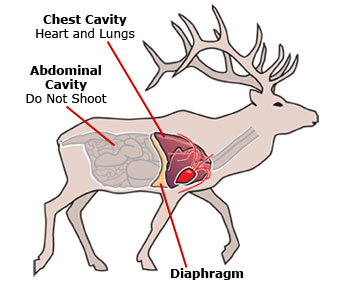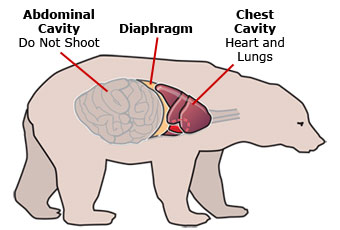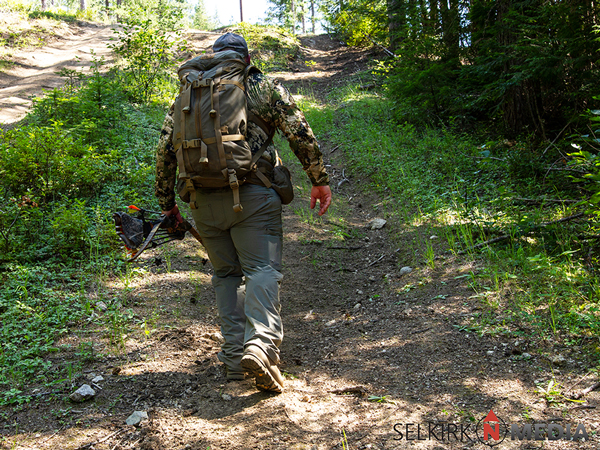Proper shot placement is critical in bowhunting because an arrow must be placed precisely for a quick, clean kill. The responsible bowhunter only takes a shot that can strike the vital area of the animal reliably and passes up anything less. Merely wounding an animal is a serious error that can be avoided if the bowhunter knows the vital area of the game being pursued.
Body Chambers of Big Game Animals
Big game animals like the white-tailed deer, elk, bear, moose, and others have anatomical features that are similar. Big game animals have two distinct body cavities: the abdominal cavity and the chest cavity. The two cavities are separated by the diaphragm muscle, the sheet-like muscle that forms the rear of the chest cavity and helps with the breathing process.
Chest Cavity: The Main Vital Area

In big game animals, the bowhunter’s primary target area lies within the animal’s chest cavity. The chest cavity holds the heart, lungs, and major arteries and veins of the body, all of which are crucial to sustain life.
- A razor-sharp broadhead shot through the chest will immediately depressurize the cavity, sever lung tissue, and cause massive bleeding. It may cut lung vessels to add to the blood loss and cut heart tissue or heart vessels that will cause even more blood loss.
- The circulatory system of a big game animal is under pressure. All cuts in the major blood vessels, lung tissue, and muscle tissue will result in immediate and sustained blood loss.
- The most effective shot for bowhunters on black bear and deer-sized or smaller animals is a diagonal shot (45 degrees) that angles forward and hits the liver, diaphragm, lungs, and heart.
- The second most effective shot is the double-lung broadside shot because it collapses both lungs. The animal leaves a good-to-excellent blood trail and typically goes a shorter distance before lying down.
Abdominal Cavity

The abdominal cavity, on the other hand, is not an aiming zone.
- The abdominal cavity holds the stomach, kidneys, liver, and small and large intestines. If the arrow strikes one of these vital organs or blood vessels, the animal may bleed to death in an hour.
- More often, a slow death begins when an arrow cuts open the stomach or intestines, spilling the contents into the abdominal cavity. The bacteria and acids in the contents cause peritonitis, a severe inflammation of the cavity. The animal becomes sick and usually dies within 8 to 12 hours.
- There may be very little external blood loss, so tracking is very difficult. However, most animals that are gut shot don’t appear badly frightened or hurt. If undisturbed, they tend to travel a short distance and then lie down, where they die peacefully.
- Even though the liver is located in the abdominal cavity, it is often hit in a quartering-away shot because of its size and location just behind the diaphragm. The arrow may pass through the front portion of the abdominal cavity and liver on its way to the chest cavity.
Shots Outside the Main Body Cavities
Broadhead-tipped arrows that do not strike the chest cavity or the abdominal cavity may still cause immediate, massive blood loss and death. For example, shots that strike the neck (carotid arteries or jugular veins) or hind legs (femoral artery) will cause death. However, these shots should never be attempted because the size of the vital area is smaller. Big game animals are likely to survive arrow strikes in the shoulders, back muscles, neck, brisket, hams, or legs.
Know the Primary Aiming Zone of Your Game Animal
Bowhunters need to learn the primary aiming zone of each big game animal they hunt. For example, the area just behind the front leg of a white-tailed deer—approximately the size of a paper plate—is the primary aiming zone. When shooting, the bowhunter focuses on an aiming spot—about the size of a quarter—in the center of the aiming zone. This provides a bull’s-eye over the vital organs.
Spine Shots
No hunter should ever attempt a spine shot because it’s too difficult to execute. However, if a spine shot should happen accidentally, quick action is required.
- When hit in the spine, the animal will drop on the spot. It won’t die immediately, so a second shot is necessary to dispatch the animal humanely.
- If an arrow hits the backbone but does not cut the spinal cord, the animal may drop from “spinal shock,” which is similar to hitting the “funny bone” in your elbow. The paralysis is temporary, and within a minute or so, the animal may get up and run away. This is a serious problem because the arrow is frequently still stuck in the backbone. Because the animal is not incapacitated or even significantly slowed, it’s likely to escape. This type of injury is not only unfortunate for the animal, but it also creates a public relations nightmare for bowhunters.
- If an animal drops instantly when hit with an arrow, you must shoot it again immediately. Don’t climb down out of your tree stand first. If you hit it the first time from where you were, you should be able to hit it with a second shot. This ensures that it won’t escape or suffer needlessly if it is paralyzed temporarily.
Special Situation: Large Bears
- Large bears present more of a challenge because of their bulk.
- The bear’s shoulder is farther forward, the shoulder bones form a tighter angle, and its hair is several inches longer than other game’s.
- Long, heavy hair makes a bear appear deeper in the chest than it actually is. As a result, many hunters aim too low or too far forward and hit the large shoulder bone.
- A spot in the center of the lungs or slightly lower should be a bowhunter’s target every time.
This information comes from the Bowhunter-Ed Michigan Study Guide.
There is a full course to get your Bowhunter Education certificate, and they also offer this service for many other states. It’s a wealth of knowledge for beginning bowhunters.







Leave A Comment